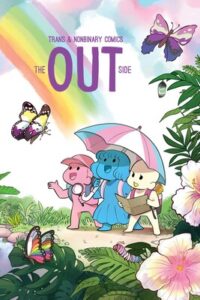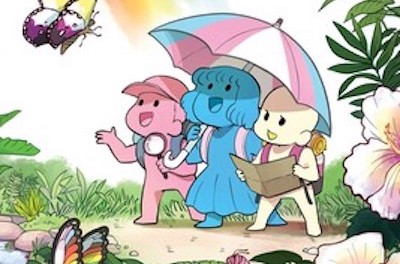The Out Side is a vibrant comic book bursting with color. As an anthology containing the work of 29 artists who identify outside the cisgender label, each comic presents a unique visual insight into the gender euphoria of its contributor.

“When I was young, it was easier to communicate through art,” says editor The Kao. “Since my parents are immigrants, and I was shy, I would show pictures of how I was feeling when I was struggling with words.” The creator of the webcomic Magical Boy and web series Mondo Mango, Kao has always been drawn to comic art. “I was always in Chinatown, where my parents worked, where I was exposed to anime and manga, and my style was inspired by that, which made me want to become a comic artist.”
For her comic, Tara Avery, founder of Stacked Deck Press, recounts growing up transgender in the 1970s. As a child, she found solace in comic books and drawing. “In my early teens, it dawned on me that people do this for a living. I could do that, too,” Avery says.
Min Christensen, co-editor of the anthology, recounts their journey to their bisexual and non-binary identity in their comic. Christensen remembers the validation that art gave them from an early age. “Adults around me started praising my art when I was young,” he says. “From there, it turned into a way to express myself in a manner I struggled with otherwise, as someone who grew up with undiagnosed autism. I was using my art and sketchbooks to express the feelings I had at the time.”
Tender reconciliations happen within these pages. Dana Simpson illustrates a conversation between her present and past selves where she reminds herself that happiness is worth pursuing. Matteo Montero-Murillo meets his past self in his story’s final, full-color panel. Aidyn Arroyal illustrates their bigender identity with a sweet embrace between the two souls in their body.
Each contributor’s creativity shows how gender continuously defies the boundaries of definition. Kaz Fantone and Cyrus depict gender dysphoria in visceral illustrations—clinging tendrils of a purple fog and an empty-eyed demon, the traditional female symbol outlining one pupil-less eye. Nasr Bin Safwan pieces together the fragments of themself to create a portrait of a happy, thriving individual. Zhen Tso uses pink, blue, and purple shading to illustrate their resistance to labels and the gender binary. Liam Coballes and Jam Aden reflect on their adventures in redefining masculinity and embracing femininity as transmasculine people, and Lae Louie Schäfer uses the “egg” metaphor to depict his coming out experience.
Each comic demonstrates the power of art to transcend language. “When we were young, we didn’t have words for different gender identities,” says Christensen, “but we had art as a means to start expressing ourselves.”
Through art, every individual has the power to tell their own unique story and shape their world. “As a child, I would draw pictures of myself as the opposite gender, and I would hide them,” recalls Avery. “Being a creative person gives you the chance to make your own adjustments to reality. That’s natural to me; that’s how I think.”
There are no boundaries to emotions on gender journeys. Maddie Jacobus finds hope in the revelation that an ancestor of hers also broke the gender binary. Lucas (The Nifty Fox) recounts the myriad of emotions surrounding his “Teet Yeet” (top surgery) with a deft balance of humor and tenderness.
“I’d like people to understand that a lot of our awareness of transgender and non-binary issues aren’t new, but that we are talking about it in a new way,” says Avery. “There were trans people then, but they weren’t prominent in media. We didn’t know what it meant to feel the way we felt. The representation we did have made it sound as though your likelihood of successfully transitioning was so vanishingly small that you might as well not even bother. I transitioned in my thirties, and it was something I carried with me for a few decades.”
Of course, gender journeys often carry personal pain. Veronica Jane reminds us, in one panel: “Even when you’re sharing your life story, there’s some parts you have to keep private.” Jane’s art validates the need for privacy even in public-facing stories. Other stories abstract the experience. Sam and Julie Fiveash connect with nature in their comics. Sam finds peace with his existence in nature, while Julie explores gender through animal illustrations.
“In Denmark, gender identity was officially seen as a mental illness. Stories like ours form a basis for community and counter these perceptions,” says Christensen. “I hope that our personal comics, in some sense, can also bring a sense of awareness to people who relate to us. It would be amazing if just one person could learn to define themself as a normal human being after reading this anthology.”
The presence of this anthology in bookstores adds a new dimension to trans and non-binary visibility. “There is more chance of people gaining awareness of our community,” adds Kao. “Hopefully, it might help someone living in secret feel like they are not alone.”
As many queer folks know, community is a nurturing force that helps us thrive. “Many hands help the plant grow,” Wren says, accompanying an illustration of multiple pairs of hands reaching out towards a single, blooming flower. “A saying I just made up.”
“We are the future,” Avery says. “We have always been here.”
The sentiment is echoed by Kyla Aiko, whose soft illustrations bring the anthology to a close. “I know how I feel…and I know who I am. And I’m happier for it.”

